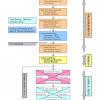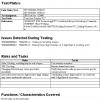Application Lifecycle Management
Articles
|
|
A ''D'' in Programming, Part 1 In certain company, the topic of favorite programming languages can elicit the same response as other taboo subjects, such as religion and politics. But, Chuck's going out on a limb to discuss his new favorite language, D, and some of its best features, such as its being strongly typed and compiling to native code, yet it is garbage collected. |
|
 |
Requirements Engineering: Our Best Practices This article focuses on a methodology adopted during a requirements and functional specification phase of a project. The chosen model for requirements engineering was founded on a combination of six sigma techniques and a set of best practices adopted from within the organization. |
Bonney Joseph
December 12, 2007 |
|
Agile Strategies for Geographically Distributed Quality Management Geographically Distributed Development (GDD) is a common strategy in the software world today. Organizations are gaining experience in developing software globally and are discovering that the competitive demand for best-in-class, high quality applications requires greater agility in quality management. Unfortunately, IT budgets are not keeping up with the staff required for quality management and the response is to accelerate quality management by leveraging global teams. This article compares and contrasts agile GDD testing strategies for affecting quality management. |
||
|
Hidden Messages A defect management system contains data such as how many defects have been raised, the priority and severity of individual defects, and even who is raising them. This information is regularly used by program and test management to guide decision making. In this article, Dan Minkin proves that an experienced test manager can gather useful information by looking at more than just the defect management system's data. |
Dan Minkin
November 27, 2007 |
|
|
Don't Let the Engine Run out of Fuel Clarke Ching's friend Gary is one of those quietly clever people who hated school, so he left as soon as he could to go work in a factory. Nowadays, years after their schoolboy days in New Zealand, Clarke works in Europe as a management consultant and Gary owns and runs a small farm in New Zealand. Their lives couldn't be more different, yet Gary taught Clarke one of the most valuable lessons Clarke has learned during his career. In this article, Clarke describes that lesson and how it has changed his approach toward dealing with customers and key players in developing a product. |
||
|
|
Capturing Implied Requirements Sometimes the user, project sponsor, and other key stakeholders haven't provided in the requirements documentation all the expectations of the software you're building. Instead, these expectations are only implied. In a perfect requirements-gathering process, there would be no such thing as an "implied requirement" because every requirement would be captured in the document. But no process is perfect, in theory or in practice. This article should help you look for and recognize the presence of implied requirements and learn how to capture them and convert them to documented requirements. |
|
|
|
Using Earned Value Management for Improving Processes This article explains earned value management and explores how the metric can be used to improve project and business processes. |
Cynthia K. West
September 11, 2007 |
|
Automatic Metrics: Turn Down the Volume and Increase Awareness Linda Hayes has always found software development metrics to be problematic. The data either skews perceptions of the project or the actions of the team members. In this article, Linda explains that by turning down the volume of what is being said and measured and simply watching what is actually happening, you can strip away the assumptions and biases that often obscure the truth. |
||
|
Interoperate or Integrate Most of the organizations in today's world have some legacy software or systems. With pressures coming from outsourcing and cost-cutting, new applications are constantly being added to existing IT frameworks. In most cases, it is risky to completely replace the existing systems. As a result, most places have complex applications and systems frameworks. In order to achieve a successful coexistence of several applications on different platforms and technology architecture, teams are faced with some major questions, such as "Should we interoperate or integrate?" |
Ipsita Chatterjee
August 14, 2007 |
|
 |
Test Notes and Coverage Maps--Aids for Rapid Testing As delivery cycles get shorter, rapid test techniques are gaining in popularity. In this article, Sridhar Kasibhatla and Andrew Robins explore the concept of using coverage maps and test notes to support exploratory testing and concurrent test design. These maps and test notes also are used to review and track test coverage and can help document dynamically generated test cases for future re-use. |







